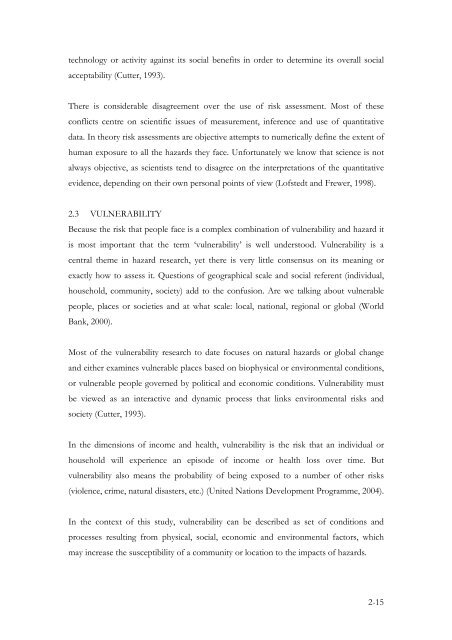A spatial multi-risk hazard assessment and vulnerability study of ...
A spatial multi-risk hazard assessment and vulnerability study of ...
A spatial multi-risk hazard assessment and vulnerability study of ...
Create successful ePaper yourself
Turn your PDF publications into a flip-book with our unique Google optimized e-Paper software.
technology or activity against its social benefits in order to determine its overall social<br />
acceptability (Cutter, 1993).<br />
There is considerable disagreement over the use <strong>of</strong> <strong>risk</strong> <strong>assessment</strong>. Most <strong>of</strong> these<br />
conflicts centre on scientific issues <strong>of</strong> measurement, inference <strong>and</strong> use <strong>of</strong> quantitative<br />
data. In theory <strong>risk</strong> <strong>assessment</strong>s are objective attempts to numerically define the extent <strong>of</strong><br />
human exposure to all the <strong>hazard</strong>s they face. Unfortunately we know that science is not<br />
always objective, as scientists tend to disagree on the interpretations <strong>of</strong> the quantitative<br />
evidence, depending on their own personal points <strong>of</strong> view (L<strong>of</strong>stedt <strong>and</strong> Frewer, 1998).<br />
2.3 VULNERABILITY<br />
Because the <strong>risk</strong> that people face is a complex combination <strong>of</strong> <strong>vulnerability</strong> <strong>and</strong> <strong>hazard</strong> it<br />
is most important that the term ‘<strong>vulnerability</strong>’ is well understood. Vulnerability is a<br />
central theme in <strong>hazard</strong> research, yet there is very little consensus on its meaning or<br />
exactly how to assess it. Questions <strong>of</strong> geographical scale <strong>and</strong> social referent (individual,<br />
household, community, society) add to the confusion. Are we talking about vulnerable<br />
people, places or societies <strong>and</strong> at what scale: local, national, regional or global (World<br />
Bank, 2000).<br />
Most <strong>of</strong> the <strong>vulnerability</strong> research to date focuses on natural <strong>hazard</strong>s or global change<br />
<strong>and</strong> either examines vulnerable places based on biophysical or environmental conditions,<br />
or vulnerable people governed by political <strong>and</strong> economic conditions. Vulnerability must<br />
be viewed as an interactive <strong>and</strong> dynamic process that links environmental <strong>risk</strong>s <strong>and</strong><br />
society (Cutter, 1993).<br />
In the dimensions <strong>of</strong> income <strong>and</strong> health, <strong>vulnerability</strong> is the <strong>risk</strong> that an individual or<br />
household will experience an episode <strong>of</strong> income or health loss over time. But<br />
<strong>vulnerability</strong> also means the probability <strong>of</strong> being exposed to a number <strong>of</strong> other <strong>risk</strong>s<br />
(violence, crime, natural disasters, etc.) (United Nations Development Programme, 2004).<br />
In the context <strong>of</strong> this <strong>study</strong>, <strong>vulnerability</strong> can be described as set <strong>of</strong> conditions <strong>and</strong><br />
processes resulting from physical, social, economic <strong>and</strong> environmental factors, which<br />
may increase the susceptibility <strong>of</strong> a community or location to the impacts <strong>of</strong> <strong>hazard</strong>s.<br />
2-15
















